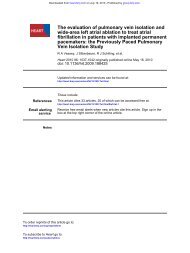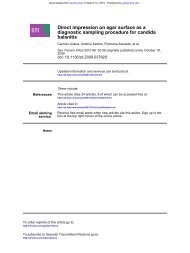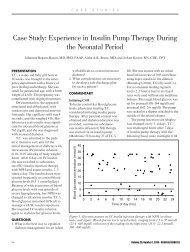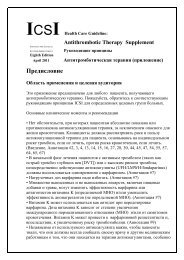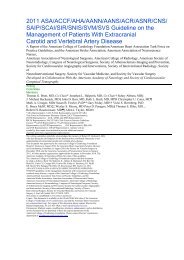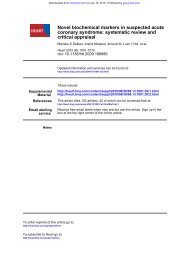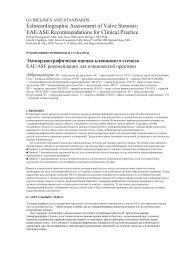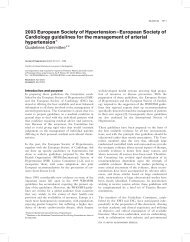echocardiography: basic principles Two dimensional speckle tracking
echocardiography: basic principles Two dimensional speckle tracking
echocardiography: basic principles Two dimensional speckle tracking
You also want an ePaper? Increase the reach of your titles
YUMPU automatically turns print PDFs into web optimized ePapers that Google loves.
Downloaded from<br />
heart.bmj.com on May 1, 2010 - Published by group.bmj.com<br />
Figure 1 Elastic deformation properties. Strain¼change<br />
of fibre length compared to original length, strain<br />
rate¼difference of tissue velocities at two distinctive<br />
points related to their distance. ΔL, change of length; L o,<br />
unstressed original length; L, length at the end of<br />
contraction; blue arrow, direction of contraction; v1,<br />
velocity point 1; v 2, velocity point 2; d, distance.<br />
during early diastole seems to reflect diastolic<br />
9 10<br />
dysfunction.<br />
Several studies have demonstrated that disturbed<br />
rotational mechanics can be found in many cardiac<br />
disease states and that specific patterns describe<br />
specific pathologies. 9e14<br />
While these parameters are assessed with the<br />
help of STE derived deformation parameters and<br />
describe the ‘mechanics’ of the entire heart, deformation<br />
parameters can also be calculated for individual<br />
segments and specific vectors of direction.<br />
Three different components of contraction have<br />
Figure 2 Mathematical relationship between different deformation parameters and<br />
mode of calculation for <strong>speckle</strong> <strong>tracking</strong> <strong>echocardiography</strong> (STE) and tissue Doppler<br />
imaging (TDI). STE primarily assesses myocardial displacement, whereas TDI primarily<br />
assesses tissue velocity. Modified from Pavlopoulos et al. 1<br />
Education in Heart<br />
been defined: radial, longitudinal, and circumferential<br />
(figure 5).<br />
< Longitudinal contraction represents motion from<br />
the base to the apex.<br />
< Radial contraction in the short axis is perpendicular<br />
to both long axis and epicardium. Thus,<br />
radial strain represents myocardial thickening<br />
and thinning.<br />
< Circumferential strain is defined as the change of<br />
the radius in the short axis, perpendicular to the<br />
radial and long axes.<br />
Longitudinal deformation is assessed from the<br />
apical views while circumferential and radial deformation<br />
are assessed from short axis views of the left<br />
ventricle. The description of these three aforementioned<br />
‘normal strains’dwhich can be measured<br />
using current STE technologydallows a good<br />
approximation of active cardiac motion. However,<br />
they still represent a simplification. When considering<br />
myocardial deformation during contraction in<br />
three <strong>dimensional</strong> space, six more ‘shear strains’ can<br />
be defined in addition to the normal strains. 1 Normal<br />
strains are caused by forces that act perpendicular to<br />
the surface of a virtual cylinder within the myocardial<br />
wall, resulting in en bloc stretching or contraction<br />
without skewing of the volume. Conversely,<br />
forces causing shear strain act parallel to the surface<br />
of such a myocardial block and lead to a shift of<br />
volume borders relative to one another as delineated<br />
by a shear angle a (figure 6).<br />
Reference values for segmental strain were<br />
established for the left ventricle and the left<br />
atrium. 15e19 Normal paediatric strain values are<br />
also available. 18 However, clear cut-offs for peak<br />
systolic strain to define pathologic conditions are<br />
still missing. Marwick et al enrolled 242 healthy<br />
individuals without cardiovascular risk factors or<br />
a history of cardiovascular disease in their multicentre<br />
study and defined normal LV longitudinal<br />
strain values as displayed in table 1. 19 Global<br />
reference values (mean6SEM) for the longitudinal<br />
peak systolic strain (GLPSS: 18.660.1%), peak<br />
systolic SR ( 1.1060.01/s), early diastolic SR<br />
(1.5560.01/s), as well as for the global late diastolic<br />
SR (1.0260.01/s) were also established. 19 Circumferential<br />
and radial LV strain reference values were<br />
determined by Hurlburt et al (table 2). 15 It appears<br />
that longitudinal strain values in the basal<br />
segments are less than in the mid and apical<br />
segments. It remains unclear if this truly reflects<br />
less contractility or if it is a methodological issue.<br />
According to current data, it does not seem necessary<br />
to adjust STE based strain or SR parameters for<br />
sex or indices of LV morphology. Studies investigating<br />
this issue only found a weak relationship or<br />
yielded conflicting results. 15 19e21 However, it has<br />
been shown that with age, LV twisting motion<br />
increases, whereas diastolic untwisting is delayed<br />
and reduced when compared to young individuals.<br />
22 Possibly this is caused by the higher incidence<br />
of diastolic dysfunction with age.<br />
Strain and SR change throughout the cardiac<br />
cycle. To describe systolic myocardial function, it is<br />
best to use peak systolic strain (which reflects<br />
Heart 2010;96:716e722. doi:10.1136/hrt.2007.141002 717


